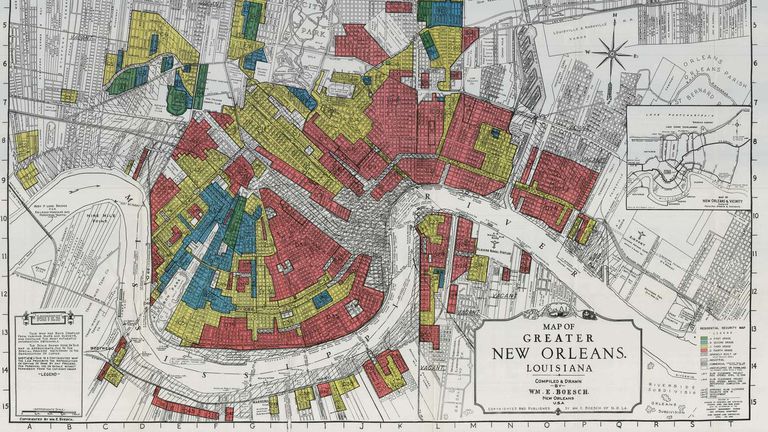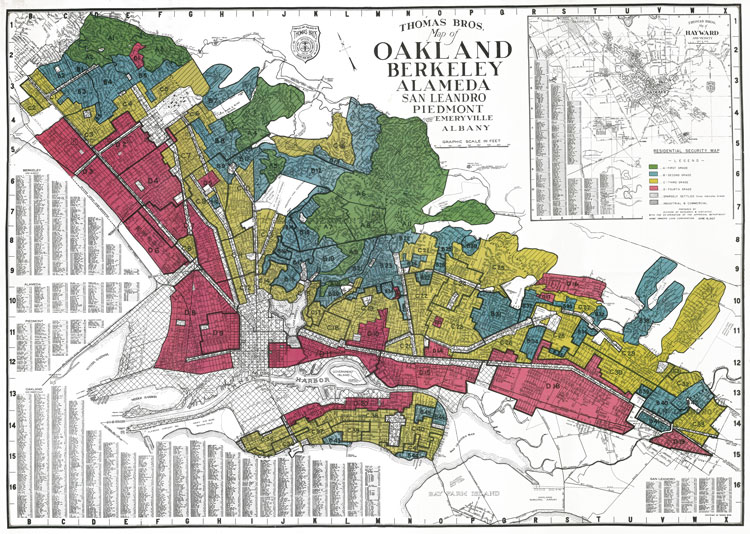
Share On Social!
Historically, white people easily got mortgages to live in America’s nicest areas, while aspiring racial/ethnic home buyers from the inner-city were refused loans from banks and federal programs.
That is what is called “redlining.”
This racially discriminatory mortgage lending practice, which gripped the nation in the 1930s before its ban in the 1960s, created a racial wealth gap and neighborhoods that lacked health-promoting assets, like healthcare, jobs, and transportation options.
Even today, three of four neighborhoods “redlined” on government maps 80 years ago continuing to struggle economically, according to a new study, Washington Post reports.
“It’s as if some of these places have been trapped in the past, locking neighborhoods into concentrated poverty,” Jason Richardson, director of research at the NCRC, a consumer advocacy group, told the Post.
So why is redlining still here? What can we do about it?
How Redlining Started
The now-defunct, government-sponsored Home Owners’ Loan Corporation (HOLC) and the Federal Housing Administration (FHA) began redlining after the Great Depression.
They wanted to incentize home ownership through mortage lending.

Maps categorized regions across the country by classifying specific areas as a non-risky or risky investment for lending — green, blue, yellow, and red zones.
Red zones had the riskiest home-loan prospects, according to HOLC.
“Green and blue neighborhoods, which usually had majority-white populations, were considered good investments. It was easy to get a loan in these areas,” according to ThoughtCo. “Yellow neighborhoods were considered “risky” and red areas—those with the highest percentage of Black residents—were ineligible for FHA backing.”
Government officials, loan officers, and real estate professionals used these maps to decide who could live where, based on race/ethnicity.
Areas with the best financial future were made available to whites. Minorities were forced to purchase homes HOLC knew could, and did, lead to economic instability.
“Lenders would literally draw a red line around a neighborhood on a map, often targeting areas with a high concentration of people of color, and then refusing to lend in those areas because they considered the so-called ‘risk’ too high,” writes Elizabeth Weintraub of The Balance.
The Impact of Redlining on Wealth
Redlining was made eventually made illegal by the Fair Housing Act of 1968.
But the damage was done.
The overtly racist practice spawned social, health inequities minorities still face today. It blocked financial development opportunities, access to proper education, government-financed homeownership, and numerous other chances to build wealth.
Most historically redlined neighborhoods remain socioeconomically poor.
“On the flip side, 91 percent of areas classified as ‘best’ in the 1930s remain middle-to-upper-income today, and 85 percent of them are still predominantly white,” according to The Washington Post report.
Homeownership still is far from the grasp of many Latinos.
Over half of Latino household heads (54%) were renting their homes in 2016, compared to 28% of White household heads, according to a new Salud America! research review.
The Ongoing Impact of Redlining on Health
Many studies show living in a historically redlined area is linked to poor self-rated health. Segregation could also be a primary driver for health disparities in these communities.
 An analysis of eight California cities shows that residents of historically redlined neighborhoods are more than twice as likely as their peers to visit emergency rooms for asthma, according to a new study by the University of California, Berkeley, and the University of California, San Francisco.
An analysis of eight California cities shows that residents of historically redlined neighborhoods are more than twice as likely as their peers to visit emergency rooms for asthma, according to a new study by the University of California, Berkeley, and the University of California, San Francisco.
Researchers also found significantly higher levels of diesel particulate matter in the air.
“Redlining maps that were drawn 80 years ago, partially on the basis of race, are still predictive of not only who lives in a neighborhood, but also what kind of health problems they are experiencing,” said Anthony Nardone of UC Berkeley-UCSF.
You can use this University of Richmond map to see how redlining affected your community.
Trump Administration to Make Redlining Easier?

A report by news outlet Reveal found that Latinos and other minorities in 48 U.S. cities are routinely denied conventional mortgage loans.
In Philadelphia (14.1% Latino), conventional home loans were given to over 12,000 whites, while roughly 1,000 Latinos were approved.
“Reveal found that African Americans and Latinos—and in some locations Asian Americans and Native Americans, too—were far more likely to be turned down for conventional mortgages than white borrowers,” The Progressive reports. “That pattern remained even after controlling for factors like household income and the amount of the loan in relation to that income.”
And redlining could soon get worse.
The Trump administration recently announced its plan to reduce public access to mortgage loan information, which could make redlining practices easier.
The Trump administration intends to roll back regulations that bar discrimination based on “disparate impact,” according to The Washington Post. In particular, Trump officials have their eyes on reducing rules that prevent discrimination in housing.
How Can We Remedy Redlining?
Terrance Hamm of the Institute for Youth, Education, and Families, and the Center for Race, Equity, and Leadership, wrote five ways to reverse the residual effects of redlining:
- Study the history of your city
- Revise policies that are implicitly racist
- Attend NLC University for REAL action training
- Incentivize investment in economically deprived areas (such as opportunity zones)
 “The nice thing about the opportunity zones programs—as opposed to other programs where people would come in, take their profit and leave, this has the long-term incentive,” said Ben Carson, the Secretary of Housing and Urban Development.
“The nice thing about the opportunity zones programs—as opposed to other programs where people would come in, take their profit and leave, this has the long-term incentive,” said Ben Carson, the Secretary of Housing and Urban Development.
Other opportunities for improvement are emerging, too.
Johnsen Del Rosario and Jarrett Ramones, members of the youth media organization called The kNOw, created a new graphic comic book on redlining to raise awareness.
Local communities can get involved, too.
In Warren, Ohio, where decades of redlining kept some parts of the city poor, advocates sponsored a discussion in May 2019 on how to end the long-lasting effects redlining had on cities. The event featured a panel discussion and presentation by Jason Reece, an assistant professor at The Ohio State University.
“This event will provide a platform for our residents to discuss issues they have faced and assist in crafting future fair housing policies,” said Shawn Carvin, land bank program director for Trumbull Neighborhood Partnership, according to the Tribune Chronicle.
To read more about further health inequities affecting the Latino population, check out Salud America!‘s latest research review —the state of housing, transportation, and green spaces.
Also, check out more stories on housing and Latino health:
Learn: Latinos & Affordable Housing!
Editor’s Note: The main image is via Mapping Inequality by way of ThoughtCo.
Explore More:
HousingBy The Numbers
56.9
percent
of Latinos are "housing cost burdened"



